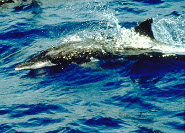 The Rough-toothed dolphin (Steno bredanensis) is often mistaken for the Bottlenose, Spinner or Spotted species, but upon closer inspection observers note unique physical characteristics specific to this animal. The dolphins appear to wear a mask, hood and cape that ranges from dark grey to black in color. The markings begin at the tip of the nose and extend back past the dorsal fin. The lips, throat and underbelly are in stark contrast with hues of white to pink. The belly surface is further marked with irregular grey or black splotches.
The Rough-toothed dolphin (Steno bredanensis) is often mistaken for the Bottlenose, Spinner or Spotted species, but upon closer inspection observers note unique physical characteristics specific to this animal. The dolphins appear to wear a mask, hood and cape that ranges from dark grey to black in color. The markings begin at the tip of the nose and extend back past the dorsal fin. The lips, throat and underbelly are in stark contrast with hues of white to pink. The belly surface is further marked with irregular grey or black splotches.The nose or beak is long, round and gently curves to form a small head. The body is stocky in appearance having dorsal and pectoral fins located further back on the body compared to other dolphins. Additionally, the fins are much larger in size. This playful sea mammal was aptly named for the wrinkled ridges on the crowns of the 22 to 27 large teeth within its mouth. Newborn rough-toothed dolphins are approximately 3 feet (0.9m) in length and grow to lengths of 8.5 feet (2.6m) as adults. Mature weight averages around 350 pounds ( 160kg). Females reach sexual maturity at around 10 years of age, but males are not mature until the age of 14.
While traveling in groups, the dolphins are noted for being extremely fast swimmers and have been seen surfing along the top of the water or skimming just below the surface. It is not uncommon for the curious animals to venture close to boats or ride along the bow waves of passing vessels. They have the capability to stay submerged for as long as 15 minutes at a time and have been seen diving to depths of 70m for food.
Rough-tooths have been observed hunting prey in a group effort and were sighted on more than one occasion attacking Mahimahi larger than 1m in length. However, the usual diet consists of various cephalopods (mollusk, squid) and fish. Like other dolphin species, the rough-tooth dolphins communicate and echolocate with shrill, high-pitched whistles and clicks.
Many times the dolphins wear scars from skirmishes with octopi, sharks or other rough-toothed dolphins. There are a few countries that hunt the mammal for its meat, but human encounters generally occur accidentally as a result of being caught in fishing gear.
The Rough-toothed dolphin is listed as Data Deficient (DD), inadequate information to make a direct, or indirect, assessment of its risk of extinction, on the IUCN Red List of Threatened Species
Namings for the roughtoothed dolphin
A young / baby of a roughtoothed dolphin is called a 'calf or pup'. The females are called 'cow' and males 'bull'. A roughtoothed dolphin group is called a 'team, school, pod, herd, alliance (male) or party (female)'.Countries
Algeria, Angola, Australia, Barbados, Brazil, Burma, China, Colombia, Costa Rica, Cote d'Ivoire, Dominican Republic, Ecuador, Egypt, El Salvador, Ethiopia, France, French Guiana, French Polynesia, Gibraltar, Greece, Guatemala, Guyana, Honduras, India, Indonesia, Israel, Italy, Jamaica, Japan, Kenya, Kiribati, Korea, North, Korea, South, Libya, Madagascar, Malaysia, Mauritania, Mexico, Micronesia, Federated States of, Morocco, Mozambique, Namibia, New Zealand, Nicaragua, Nigeria, Oman, Pakistan, Panama, Papua New Guinea, Peru, Philippines, Portugal, Puerto Rico, Saint Helena, Saint Vincent and the Grenadines, Senegal, Somalia, South Africa, Spain, Sri Lanka, Suriname, Tanzania, Thailand, Trinidad and Tobago, Tunisia, Turks and Caicos Islands, United States, Uruguay, Venezuela, Virgin Islands, Western Sahara and YemenSome facts about the
Rough-toothed dolphin
Adult weight : 114 kg (250.8 lbs)
Maximum longevity : 32 years
Female maturity :3650 days

Custom Search